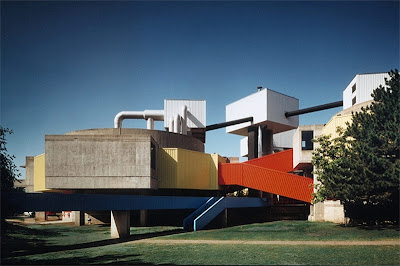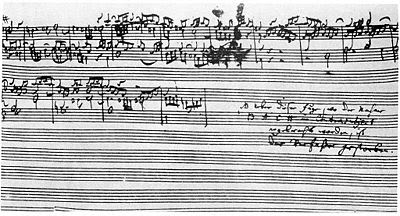Gehry and Cohorts
This blog has, for the most part, highlighted architecture (both good and bad) that follows standard rules of geometry and sits on the ground without challenging gravity -- architecture that is created with orthogonal projection and follows tested rules.
 |
| 1. Disney Concert Hall by Frank Gehry. |
 |
| 2. Denver Art Museum by Daniel Liebeskind. |
The time has come to talk about amorphous architecture. It is a class of architecture that follows no rules of form, proportion, symmetry -- architecture that seems to spring from nothing, with arbitrary shapes and capricious flourishes. Think Frank Gehry. His buildings would be all but impossible without computer modeling to engineer the irregular geometry. In interviews, Gehry has indicated that his buildings are sculpted for interesting shapes. Their underlying function is a secondary consideration. The result is amorphous architecture. We can lump into this category some of Gehry's contemporaries like Daniel Liebeskind and Rem Koolhaas.
The amorphous movement - if a movement it is - did not emerge from whole cloth in the last few years. Gehry's Bilbao museum is not the first building that has eschewed parallel lines. It has antecedents. To evaluate amorphous architecture it is helpful and interesting to look at its previous incarnations.
Frederick Kiesler and the Endless House
In 1958 Frederick Kiesler designed a house with curved walls, looking much like a hornet's nest. He called his design the Endless House. It existed as a large-scale model and was extensively documented in his book
The Endless House. Kiesler was more artist than architect. His unbuilt house might be taken as a metaphor for life and art: no beginning, no end; process over form; journey above destination. Kiesler never led an architectural movement, but his ideas about space without boundaries permeate modern architectural thought.
 |
| 3. Frederick Kiesler with his model of the Endless House. |
 |
4. One of Kiesler's many drawings
of the Endless House. |
 |
| 5. Plan and elevations for the Endless House. |
Rudolf Steiner and Anthroposophy
Another architect with a limited body of work (about seventeen buildings) but far-reaching influence was Rudolf Steiner. (Austria, 1861-1925.) He is better known as a philosopher, writer, and creator of the Waldorf system of education. His architectural works are vehicles for his philosophical/spiritual theories. Steiner's buildings deliberately ignore the usual ideas of structure in the physical world to express an underlying spiritual world. Steiner's spiritual world was one of imprecise form. His architectural connections to the spirit world were deliberately (stubbornly) unfocused. Steiner's world was seen through a gauzy veil. The development of steel-reinforced concrete was perfect for his designs. However, like his spiritual philosophy and his art, his buildings had a woozy quality. And, because his spiritualism included both evil and good, his buildings, at times, seem heavy and dark. Steiner's version of amorphous architecture appears to have been a dead end, even though (particularly within the Waldorf movement) some architects still experiment with his ideas.
 |
| 6. The Second Goetheanum by Rudolf Steiner. |
 |
| 7. The Stuttgart Eurythmeum by Steiner. |
The Metabolists
 |
| 8. Pompideu Center in Paris. |
The late twentieth century saw a lot of experiments within the broader context of modern architecture. A briefly popular (but widespread) fad was metabolism. (It blended with high tech, which is another discussion.) Japan, Europe, and the United States all had champions for metabolism. The metabolist idea, as the name suggests, is that buildings are like living organisms. As such, they might morph and change over time and the proper way to address this is to treat a building as a kit of parts that can be replaced or augmented as needed. Like Tinker Toys. The Pompidou Center, opened in 1977 in Paris (Renzo Piano, architect), is a prime example. Where a traditional building will go to great lengths to conceal stairs, HVAC pipes, and other practical necessities, the Pompidou Center celebrates all its parts by expressing them at every opportunity. It is a kind of mechanical organic-ism. Another notable example is John Johannsen's Mummers Theater in Oklahoma City (1970). The metabolists considered Pompidou Center and Mummers Theater
honest architecture. Critics said these buildings were wearing their insides on their outsides... and why would you do
that? Curved forms and sculptural shapes were not a particular hallmark of metabolism as with Gehry or Steiner. However, because proportion and symmetry were irrelevant to the metabolism, it is a type of amorphous architecture.
 |
| 9. Mummers Theater in Oklahoma City. |
Conclusion
Amorphous architecture is not new. The impulse toward it reflects deeper urges for independence, invention, and liberation. Liberation from what? Old ideas.
This invites other questions. Does it take extreme forms to make the case for a new attitude toward our understanding of space? Or is it an immature rebellion -- equivalent to shock radio or anarchistic demonstrations? There are many reasons to question amorphous architecture, even as examples of it continue to parade across the architectural stage. Other architects and philosophies seem able to develop ideas that are reformative without grandstanding. It will be interesting to follow the course of amorphous architecture to see where it goes and what parts of it have lasting power.
Photos:
1. Rob Munger
2. Frank Vanbetlehem
3 thru 9. Unknown












.jpg)







